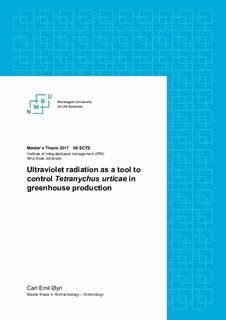Ultraviolet radiation as a tool to control Tetranychus urticae in greenhouse production
Master thesis
Submitted version
Permanent lenke
http://hdl.handle.net/11250/2483290Utgivelsesdato
2017Metadata
Vis full innførselSamlinger
- Master's theses (IPV) [240]
Sammendrag
Tetranychus urticae Koch has an ubiquitous distribution, is remarkably polyphagous and is known to be the most acaricide resistant arthropod. This thesis examines how short wavelengths of ultraviolet radiation (UV) can be used to kill and suppress T. urticae populations in a greenhouse environment. T. urticae was exposed to three minutes of indirect UV (288 ± 36 J/m2/day) every night for 14 and 21 days, using cucumber (Cucumis sativus ‘Parka’) as host plants. UV was administered in combination with both reflectors and Green LED light to increase the exposure mites received. Alive and dead individuals were counted and categorized into four life-stage groups (eggs, larvae, nymphs and adults). Mortality was most prolific when UV was combined with either reflectors or both reflectors and Green LEDs, UV alone or combined with Green LEDs were less effective at reducing T. urticae populations. The deleterious effects of UV affected all but the adult stage of T. urticae. Green LED light exposure did not have the intended positive phototaxis effect of luring mites to the axial side of leaves before UV treatment was initiated, but this may have been caused by the high intensity of the green light (17,11 ± 2,28 W/m2) transmitting through the leaves.

